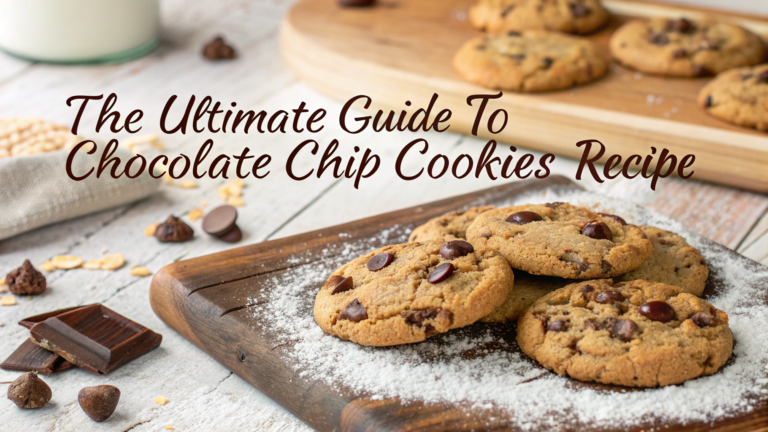Mastering the Nestle Toll House Cookie Recipe: Homemade Chocolate Chip Cookies Tips and Tricks
Introduction
Imagine this: you’re in your kitchen, and the rich aroma of melting chocolate and warm butter fills the air. You pull out a tray of golden-brown cookies, each one a perfect blend of crispy edges and soft, gooey centers. There’s a reason the Nestle Toll House cookie recipe has stood the test of time—it’s a classic that delivers happiness in every bite. But baking the perfect batch isn’t always straightforward. With the right tips and tricks, you can elevate your homemade cookies to bakery-level perfection. This guide will show you how.
Table of Contents
The History of the Nestle Toll House Cookie Recipe
Every great recipe has a story, and the Toll House cookie is no exception. In the 1930s, Ruth Wakefield of the Toll House Inn in Massachusetts accidentally created what would become America’s favorite cookie. She added chopped Nestle chocolate to her butter cookie dough, expecting it to melt into the batter. Instead, the chocolate held its shape, creating delightful pockets of sweetness. The recipe gained popularity, and Nestle eventually struck a deal with Ruth to print it on their chocolate packaging—a move that cemented its place in culinary history. Today, it’s more than just a recipe; it’s a tradition.
Essential Ingredients for Perfect Homemade Cookies
The Standard Recipe
To get started, you’ll need the classic ingredients. Here’s a quick breakdown:
| Ingredient | Quantity | Purpose |
|---|---|---|
| Unsalted butter | 1 cup (softened) | Adds richness and texture |
| Granulated sugar | ¾ cup | Contributes sweetness and structure |
| Brown sugar | ¾ cup | Adds a caramel-like flavor |
| Vanilla extract | 1 tsp | Enhances overall flavor |
| Eggs | 2 large | Provides structure and moisture |
| All-purpose flour | 2 ¼ cups | Forms the base of the cookie dough |
| Baking soda | 1 tsp | Leavening agent |
| Salt | ½ tsp | Balances sweetness |
| Semi-sweet chocolate chips | 2 cups | Key ingredient for iconic taste |

Ingredient Tips and Substitutions
- Butter: Opt for European-style butter for extra creaminess.
- Sugar: Use dark brown sugar for a richer, molasses-like flavor.
- Chocolate: Substitute semi-sweet chips with bittersweet chunks, white chocolate, or even peanut butter chips for variety.
- Gluten-Free Options: Replace all-purpose flour with a gluten-free baking blend without compromising taste.
Mastering the Technique: Tips and Tricks
Mixing the Dough
The way you handle your ingredients can make or break your cookies. Here are some tips:
- Cream the Butter and Sugar: Beat them until light and fluffy. This step incorporates air, giving your cookies a tender texture.
- Add Eggs One at a Time: This ensures even mixing and prevents a lumpy batter.
- Don’t Overmix the Flour: Stir just until combined to avoid tough cookies.
Perfecting the Bake
Baking is both art and science. Follow these guidelines for perfect results:
- Chill the Dough: Refrigerate for at least 30 minutes to prevent spreading during baking.
- Use Parchment Paper or Silicone Mats: These help with even heat distribution and make cleanup easier.
- Monitor the Baking Time: Bake at 375°F for 8-10 minutes, pulling them out when the edges are golden but the centers look slightly underdone. They’ll continue cooking on the tray.
Secret Additions for Extra Flavor
- Sprinkle a pinch of sea salt on top before baking for a gourmet touch.
- Mix in chopped nuts, shredded coconut, or dried fruit for added texture and flavor.
- Add a splash of espresso powder to intensify the chocolate flavor.

Common Cookie Mistakes and How to Avoid Them
Why Do Cookies Spread Too Much?
- Solution: Chill the dough thoroughly. Soft butter can cause spreading, so keep it cool.
Why Are My Cookies Tough?
- Solution: Overmixing develops gluten, leading to toughness. Mix only until combined.
Why Are My Cookies Unevenly Baked?
- Solution: Bake one tray at a time and rotate it halfway through the baking process.
Storing and Freezing Homemade Chocolate Chip Cookies
Storing Tips
- Airtight Containers: Store cookies in an airtight container at room temperature for up to a week.
- Keep Them Soft: Add a slice of bread to the container. The moisture in the bread prevents cookies from drying out.
Freezing Tips
- For Raw Dough: Scoop the dough into balls, freeze on a tray, then transfer to a freezer bag. Bake directly from frozen, adding 2-3 minutes to the baking time.
- For Baked Cookies: Layer cookies in an airtight container with parchment paper between each layer. Thaw at room temperature before serving.
Frequently Asked Questions (FAQs)
Can I Use Salted Butter Instead of Unsalted?
Yes, but reduce the added salt in the recipe by half to balance flavors.
How Do I Make My Cookies Softer?
Chilling the dough and pulling the cookies out of the oven slightly underbaked are key to achieving a soft texture.
Can I Make the Recipe Gluten-Free?
Absolutely! Replace all-purpose flour with a 1-to-1 gluten-free baking blend. You may need to adjust the baking time slightly.
What’s the Best Way to Reheat Cookies?
Wrap a cookie in a damp paper towel and microwave for 10-15 seconds for that fresh-from-the-oven feel.
Conclusion
The Nestle Toll House cookie recipe is more than just a list of ingredients—it’s a doorway to creating moments of joy. By mastering the techniques and incorporating these tips, you can take this classic to the next level. Whether you’re baking for a family gathering, a gift, or just to treat yourself, these cookies are sure to delight. So roll up your sleeves, preheat your oven, and let the magic of baking begin.
Don’t forget to share your baking adventures in the comments below. Happy baking!




